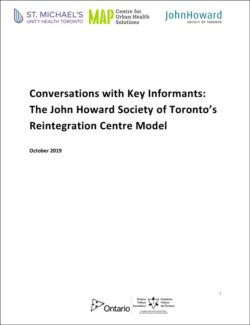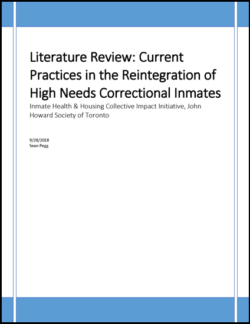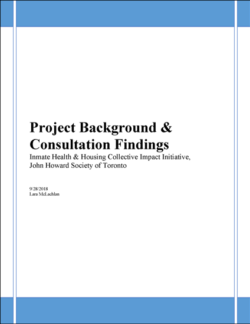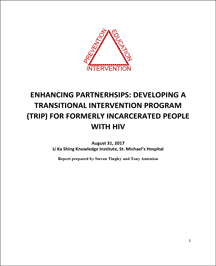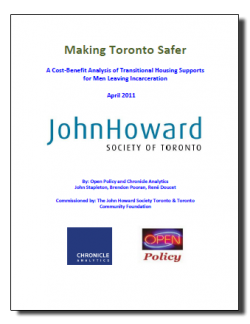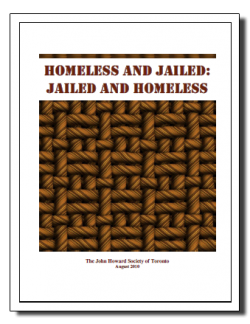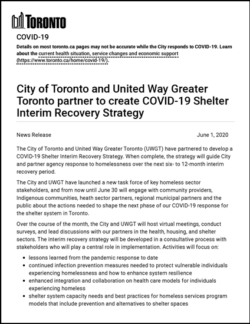Services Across Canada
To find out more about your provincial/territorial John Howard Society, click on your province below. These links will take you to the respective homepage for your region. (There are currently no provincial JHS societies for Nunavut or Yukon Territory).
RESEARCH PAPERS
Conversations with Key Informants:
The John Howard Society of Toronto’s
Reintegration Centre Model
October 2019
By: Matheson FI, Kellen A (JHST), Tacchini G, Kryszajtys D, Hamilton-Wright, S (October 2019). Conversations with Key Informants: The John Howard Society of Toronto’s Reintegration Centre Model.
Executive Summary
The Reintegration Centre (RC) opened in 2014. It is a unique community HUB model that provides services to people leaving the Toronto South Detention Centre (TDSC) in South Etobicoke, Ontario. The HUB originated through the joint collaboration of the John Howard Society of Toronto (JHS-T), the Ministry of the Solicitor General (formerly Ministry of Community Safety and Correctional Services), and service provider agencies active in the Greater Toronto Area. Located a few blocks from the TSDC, its staff provides immediate access to services and/or referrals to programs for people upon discharge from the jail. The RC offers individuals access to seasonal clothing, food, overdose prevention education, harm reduction tools, transportation assistance, and phone and computer access. A key aspect of the RC model is the integration of peer support workers (people with lived experience of incarceration and/or substance use, and/or the mental health system). The peer model and the collaboration with other service providers allows clients to access emergency shelter and housing, employment and mental health services, income benefits, and substance use resources.
This report provides findings from a process evaluation of the RC wherein the research team conducted interviews with nine key informants about their views on the original conceptualization and implementation of the RC model. These informants were service partners during the RC’s implementation. The findings of the evaluation suggest key recommendations to improve the delivery of services.
Three overarching themes emerged through the qualitative analysis. They included the initial vision of the model, challenges with the model’s implementation, and strengths of the model. In November 2018, JHS-T participated, as a party with full standing in the Inquest into the death of Mr. Bradley Chapman1, who died of a drug overdose weeks after being released from the TSDC in 2015. The Inquest produced fifty-five recommendations, seven in alignment with the findings of this evaluation. The recommendations focus on the following: the need for transitional housing and beds, a sustainable funding model, location of the RC and the ability to reach clients released from other institutions, and improved coordination and communication between the RC and the TSDC and between the RC and affiliated service partners.
Literature Review: Current Practices in the Reintegration of High Needs Correctional Inmates
Inmate Health & Housing Collective Impact Initiative, John Howard Society of Toronto
September 2018
By: Sean Pegg
This literature review examines recent research and reporting on reintegration programs and services for inmates leaving correctional institutions. The focus is on populations with high and multiple needs, including but not limited to dual diagnosis (i.e. mental illness and addiction) and multiple concurrent conditions (including chronic physical conditions and developmental and/or learning disabilities). The review includes a focus on transitional and permanent housing programs, with particular attention to supportive housing initiatives.
Project Background & Consultation Findings
Inmate Health & Housing Collective Impact Initiative, John Howard Society of Toronto
September 2018
By: Lara McLachlan
Project Background
There is a segment of the population that is cycling between jails, shelters and hospitals. These individuals typically have multiple chronic conditions, persistent mental health issues, problematic substance use, cognitive impairment and other long-standing health challenges. Without stable housing, they are trapped in a vicious cycle where justice-involvement, chronic health issues and homelessness have become deeply linked. There are currently very few ways out of this cycle for those caught within it. It is also extremely expensive and multiple levels of government are implicated by it.
Individuals with “complex health needs” are synonymous with Ontario’s Health Link1 target population which are known to be the top 5% of Ontario’s health care users. These individuals typically have 4+ chronic/high cost conditions, often struggle with mental health and addictions, are frail elderly and/or palliative, and have challenges with several social determinants of health, such as housing and income. Since 2012, Health Link has been focused on identifying these individuals, better coordinating care for the population through coordinated care planning and management and strengthening attachment to primary care.
Enhancing Partnerhsips: Developing a Transitional Intervention Program (Trip) for Formerly Incarcerated People with Hiv
August 2017
By: Steven Tingley and Tony Antoniou
Background and Rationale: Why is a TRIP needed?
Disproportionate prevalence of HIV infection within Canadian correctional facilities
In Canada, individuals sentenced to incarceration for a period of two years or greater serve their time in federal correctional facilitates operated by Correctional Service Canada (CSC). Of the 17,891 individuals incarcerated in a federal penitentiary in 2008, the prevalence of HIV infection was 1.72%, approximately 17 times greater than the national prevalence of 0.1%. Of note, the prevalence of HIV among female inmates of federal penitentiaries was 4.71%, exceeding the national prevalence of HIV among Canadian women 47-fold. These data are similar to those obtained in various provincial correctional facilities and remand facilities, which collectively house a population of persons living with HIV that exceeds that of federal penitentiaries. In a cross-sectional study of adults admitted to Ontario remand facilities in 2003, the prevalence of HIV was 2.1% among male inmates and 1.8% among female inmates. Based on these data, the authors estimated that 1,079 adults living with HIV were admitted to Ontario remand facilities from April 1, 2003 to March 31, 2004, representing 9.7% of HIV-infected adults who had entered care during this same period. Importantly, most incarcerated adults living with HIV are eventually released back to the community. Remand facilities and provincial prisons, in particular, are characterized by short stays and rapid turnover, such that the mean length of stay in Ontario remand facilities is 32.2 days, with 50% of stays in these facilities lasting 9 days or less. There is therefore considerable movement between the correctional system and the community. Without mechanisms to facilitate re-engagement with health and social support services, formerly incarcerated people with HIV are at risk of poor health outcomes.
Making Toronto Safer
A Cost-Benefit Analysis of Transitional Housing Supports for Men Leaving Incarceration
The John Howard Society of Toronto
April 2011
By: Open Policy and Chronicle Analytics
John Stapleton, Brendon Pooran, René Doucet
Commissioned by: The John Howard Society Toronto & Toronto Community Foundation
Executive Summary
In early 2010, the John Howard Society of Toronto commissioned a cost benefit study and analysis of Transitional Housing and supports (THS) for two types of ex-prisoners moving to the community from incarceration. The first group is comprised of homeless ex-offenders while the latter group is comprised of s810 sexual offenders. The proposition was to calculate the cost savings (if any) associated with the intervention of Transitional Housing and supports as opposed to their absence.
The cost benefit study framed the intervention of THS as a public good and a service to the community as well as the ex-prisoner and assessed the benefit with all public stakeholders in mind. The latest available data was used to conduct the study. John Stapleton (Principal of Open Policy Ontario) in partnerships with Brendon Pooran and Rene Doucet (Chronicle Analytics) completed the study in November 2010.
The next step is to file a funding application to the City of Toronto to expand THS. If John Howard Toronto expands the support services and access to housing for those who have completed their sentencing in a correctional facility, it believes that the recidivism rate (re-offending rate) will decline. Lower recidivism is accepted as an important indicator of community safety.
Homeless and Jailed: Jailed and Homeless
The John Howard Society of Toronto
August 2010
By: Amber Kellen, Project Director
Julie Freedman, Project Supervisor
Sylvia Novac and Linda Lapointe, Co-researchers
Richard Maaranen, Spatial Data Analyst
Angeline Wong, Lead Interviewer
This research was made possible with funding from the Homelessness Partnering Secretariat of Human Resources and Development Canada under the Homelessness Knowledge Development Program (HKDP).
Executive Summary
Previous research has established that being homeless increases the likelihood of ending up in jail, while imprisonment increases the risk of homelessness and the length of time that homeless people spend in shelters. The number of homeless prisoners in Toronto area jails is increasing. And a small, but growing, number of men are caught in a revolving door between jails and shelters.
This report explores the housing situation of adult men serving sentences in Toronto area jails, focusing on those who are homeless. These prisoners‘ housing plans on discharge, as well as their immediate and anticipated service needs in the months after release, are documented. Their residential locations are mapped in relation to selected neighbourhood characteristics.
The survey results are based on interviews with 363 sentenced prisoners who have spent a minimum of five consecutive nights in custody and who are within days of scheduled release from one of four provincial correctional facilities in the Greater Toronto Area.
Among this group, 22.9 percent, or roughly one of every five prisoners, was homeless when incarcerated, that is they were staying in a shelter, living on the street (in places considered unfit for human habitation), in a treatment facility, or staying at the home of a friend, paying no rent. The latter situation is a common form of hidden homelessness; if persons in that situation are excluded, in line with a more conservative definition of homelessness, a total of 19.3 percent were homeless.
The average stay in custody was a little more than two months. Within days of discharge, the prisoners‘ housing plans indicate that their overall projected rate of homelessness would increase by 40 percent. Half of them plan to return to their pre-custody housing situation, even if it meant staying in a shelter, on the street, or using a friend‘s couch. Of those who were homeless before being incarcerated, the majority, 85.5 percent, anticipate being homeless again on discharge. Among prisoners who were housed before being incarcerated, 16.4 percent anticipate being homeless upon discharge.
Thirteen percent of the survey respondents were homeless both before and after being incarcerated.
Overall, 32.2 percent, or almost one of every three prisoners had plans upon discharge to go a shelter, live on the street, or couch-surf at the home of a friend. Another 12 percent of these prisoners are at risk of being homeless since they do not know where they will go. If these two groups are combined, a total of 44.6 percent are homeless or at risk of homelessness. This is a large, identifiable stream of people who should be targeted for assistance to reduce chronic homelessness. Analysts have pointed out repeatedly that relative to other homeless sub-groups, those who are chronically homeless have the greatest need for appropriate housing and services, an investment that would provide the largest social returns (Trypuc and Robinson 2009).
Homeless prisoners are a vulnerable group – they tend to be older, 22.3 percent are 50 years of age or older. A high proportion of them, 43.3 percent, have severe health impairments. Most of them rely on income support programs, whose benefits they lose while in jail; in many cases, they must re-apply for these benefits after they are discharged.
Homeless prisoners requested more types of service to deal with community re-entry than housed prisoners. Yet, almost all the prisoners (95 percent) said they needed various kinds of support.
Overall, the survey respondents were only slightly more likely than the general population to have been living in City-designated priority neighbourhoods which lack adequate services for the needs of residents. Homeless prisoners, however, were more likely to have been living either in priority neighbourhoods, many of which are in the inner suburbs, or downtown where services are concentrated.
Justice and Injustice
Homelessness, Crime, Victimization, and the Criminal Justice System
By Sylvia Novac, Joe Hermer, Emily Paradis, and Amber Kellen
Centre for Urban and Community Studies, University of Toronto with The John Howard Society of Toronto
November 2006
Executive Summary
Using the situation in Toronto as a case study, this multi‐method study explores various aspects of the
relationship between homelessness and the criminal justice system. The research was based on a
literature review; analysis of administrative data; review of client files; survey of 57 homeless individuals;
in‐depth interviews with 22 homeless individuals; focus groups with homeless individuals and service
providers; interviews with 23 key informants; and extensive compilation of prevention programs.
The literature review covers research findings on the high prevalence of incarceration among homeless
adults and youth; the vulnerability of homeless individuals with mental illness and patterns of
transinstitutionalization; the high prevalence of homelessness among ex‐offenders; criminalization of
homelessness and the regulation of public space; types of offences committed by homeless people; the
high level of victimization of homeless people; treatment of homeless people by the police and courts;
cost‐effectiveness of housing provision versus institutional facilities; and service needs, issues, and
recommendations.
Major findings include the following:
• The numbers of homeless persons arrested and cycling between jail and shelter are increasing yearly.
• Clients of the John Howard Society of Toronto who were homeless at intake had fewer violent, but
more property‐related, charges than those who were housed.
• Homeless individuals appreciate the need for law and order, but are highly critical of perceived unfair
policing practices, especially differential treatment of racialized persons.
• Although homeless individuals experience a high level of victimization, they are quite reluctant to
report crimes to the police and feel alienated from police protection.
• Lack of service co‐ordination and adequate discharge planning are major barriers to the community
reintegration of ex‐prisoners and contribute to homelessness.
Suggestions for change focus on provision of transitional and supportive housing, improved discharge
planning in provincial correctional facilities, and specialized programs for vulnerable sub‐groups.
Part Two of the report is a catalogue of more than 70 programs and policies to reduce homelessness
among ex‐prisoners and the incarceration of homeless individuals, and ten promising practices.
Important Initiatives with JHST Involvement
City of Toronto and United Way Greater
Toronto partner to create COVID-19 Shelter
Interim Recovery Strategy
The City of Toronto and United Way Greater Toronto (UWGT) have partnered to develop a
COVID-19 Shelter Interim Recovery Strategy. When complete, the strategy will guide City
and partner agency response to homelessness over the next six- to 12-month interim
recovery period.
The City and UWGT have launched a new task force of key homeless sector
stakeholders, and from now until June 30 will engage with community providers,
Indigenous communities, heath sector partners, regional municipal partners and the
public about the actions needed to shape the next phase of our COVID-19 response for
the shelter system in Toronto.
 Toronto Supportive Housing Growth Plan
Toronto Supportive Housing Growth Plan
There Is An Urgent Need For More Supportive Housing In Toronto
There are now more than 15,000 people on the Access Point wait list. We need a variety of housing-and-support models for people experiencing serious mental health issues, addictions, or chronic homelessness.
Supportive housing is recognized as the long-term solution for many people on the streets and in shelters, and many people in hospitals or correctional institutions.
Providers and governments have taken real steps in the past decade to create more supportive housing, but this activity is not sufficient to meet the needs.













